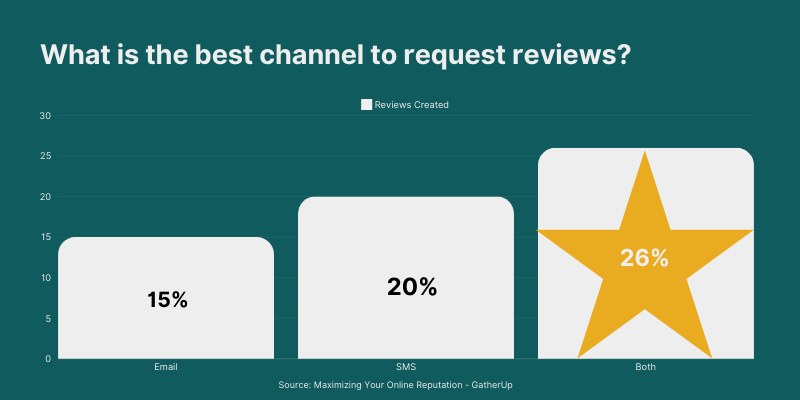When you run a local business, you need your campaigns and messages to reach your customers quickly and easily. Today, this usually means reaching people in real-time on their smartphones. Every minute matters when you want a return on your efforts. So, we analyzed SMS vs. Email to help you decide which channel is better.
Take review generation, for example. To generate more customer reviews, you need to send out more review requests. But is it better to use SMS (short message service—a.k.a. texts) so the customer sees it right away, or email, which they may not get to for a while?
The answer, which may surprise you, is both. But there’s a little more to it than that.
We recently analyzed information from GatherUp customers who use SMS, email, or a combination of the two to send review requests. We’ll look at each channel and what the approximate return is when sending 100 requests, as well as give tips for how and when to use either one. Then we’ll show how using SMS and email together can help you generate the most reviews. So who is the winner of the SMS vs. Email matchup? Read on.
Email still works
Email has been around for a while, so it makes sense that many businesses use it regularly to communicate with customers. As a personalized form of communication, email helps segment and target customers with a review request. Unlike SMS (which we’ll discuss below), you don’t have to worry about the number of words or characters you use, so you have a bit more flexibility in crafting your message.
But one challenge with emails is that they can sit around in inboxes unnoticed, sometimes for hours at a time. Though people can access email on their phones, some may not check it consistently. Or if they check it, they may not respond right away.
That being said, there are plenty of businesses that consider email to be a reliable method for requesting reviews, so there’s no reason to give up on it if it’s working for you.
For review requests: What’s the return?
- Our data showed that, for all industries, businesses that only used email for review requests generated around 15 reviews per 100 requests sent — or a 15% return on their efforts.
If email is your preferred method, here’s how to get the best results with it. Use email:
- When you want to reach a large portion of your audience as part of a big review generation campaign.
- For lengthier, more detailed review requests, you don’t have to worry about word count limitations.
- When personalization matters to your customers since you have the space to create highly individualized requests.
SMS is better
The age of smartphones has made texting nearly ubiquitous from person to person — but now, globally, 66% of people use text messaging to engage with brands and businesses. So getting a review request via SMS is pretty par for the course.
But as with any new marketing channel that gains popularity, there’s a learning curve and a comfort level that needs to be established before every business adopts it. Using SMS requires implementing special software, having access to customer phone numbers, and paying attention to things like compliance and character count.
A comprehensive reputation management platform like GatherUp that includes SMS capabilities is a great solution, since you can access customer data, craft a brief request, and text it out — all from the same place — while ensuring compliance with SMS rules and standards.
Of the businesses that are on board with using SMS for review requests, they’re generally having good luck with it — and, here’s the key, getting more reviews than when they use email. The convenience factor likely has a lot to do with that, since people can see and respond to texts much faster than they can with email — therefore helping you generate reviews in greater volume and at a higher velocity.
For review requests: What’s the return?
- Our data showed that, for all industries, businesses that only used SMS for review requests generated around 20 reviews per 100 requests sent — or a 20% return on their efforts. This gives SMS a small edge over email.
If SMS is your preferred method, here’s how to get the best results with it. Use SMS:
- To get in front of customers immediately — such as right after a purchase.
- For requests you can keep it to 160 characters or less — including the link for customers to leave the review.
- During appropriate business hours — usually considered between 8 a.m. – 9 p.m. in the time zone(s) where your customers live — so you don’t violate SMS compliance.
The SMS vs. Email winner?
SMS + email = the best results
If your overall goal is to increase your total reviews (both first- and third-party), then using both SMS and email for review requests is the best way to go. You can get more first-party reviews, which your customers give to your business directly. And you can get even more third-party reviews, which your customers give to independent or industry-specific review sites, as well as search engines like Google.
For review requests: What’s the return?
- Our data showed that, for all industries, when businesses used both SMS and email for review requests, they generated more reviews than either channel alone — 26 reviews per 100 requests sent, or a 26% return on their efforts.
We can look at this from another angle: If you’re already using SMS marketing in your business, you can get the most bang for your buck when you text your customers with review requests. But if you’re able to use SMS and email together, you increase your chances of getting a response because you’re able to reach more of your audience through their preferred channel, whether SMS or email.
One important tip: Start by sending review requests using the channel your customers are most familiar with. For example, if you never text your customers, don’t suddenly start texting them with review requests. Instead, if your customers are used to getting emails from you, then begin there and introduce SMS along the way.
The key takeaway is that there is a place for both SMS and email, depending on the specific makeup and needs of your business and what your customers already expect. But there’s also a huge opportunity to add SMS if you haven’t already done so. It’s relevant, popular, easy to use, and the direction so much of consumer communication is headed anyway. Plus, as we’ve shown, you can’t go wrong including it in your review request strategy.
To learn how GatherUp’s reputation management platform can support your insurance business, request a consultation with one of our reputation experts today.


